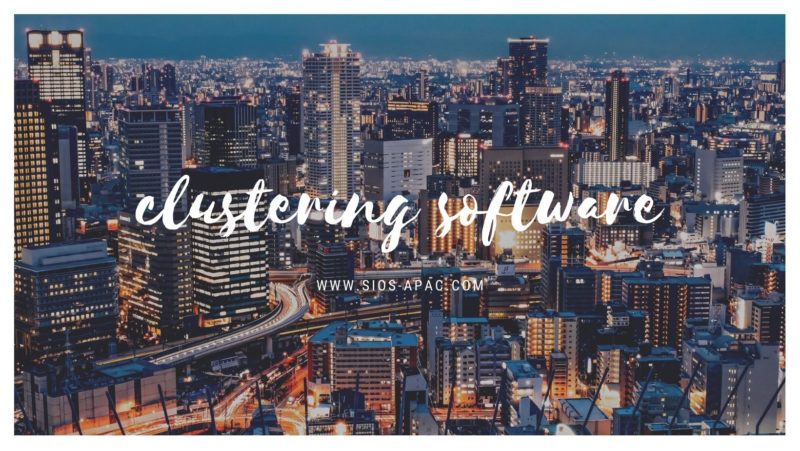Date: November 13, 2021
Tags: Clustering
Clustering Software
Clustering Software for High Availability and Disaster Recovery
What is Clustering Software?
Clustering software lets you configure your servers as a grouping or cluster so that multiple servers can work together to provide availability and prevent data loss. Each server maintains the same information – operating systems, applications, and data. If one server fails, another server immediately picks up the workload. IT professionals rely on clustering to eliminate a single point of failure and minimize the risk of downtime. In fact, 86 percent of all organizations are operating their HA applications with some kind of clustering or high availability mechanism in place.[1]
Types of Cluster Management Software
There are a variety of cluster management software solutions available for Windows and Linux distributions. Examples include:
- Windows Server Failover Clustering (WSFC),
- SUSE Linux Enterprise High Availability Extension,
- Red Hat Cluster Suite,
- Oracle Real Application Clusters (RAC), and
- SIOS software.
Except for SIOS, these products support a single operating system or require expensive SAN hardware, constraining flexibility and deployment options. Moreover, Linux open-source HA extensions require a high degree of technical skill, creating complexity and reliability issues that challenge most operators.
SIOS products uniquely protect any Windows- or Linux-based application operating in physical, virtual, cloud or hybrid cloud environments and in any combination of site or disaster recovery scenarios. Applications such as SAP and databases, including Oracle, SQL Server, DB2, SAP HANA and many others, benefit from SIOS software. The “out-of-the-box” simplicity, configuration flexibility, reliability, performance, and cost-effectiveness of SIOS products set them apart from other clustering software.
How SIOS Clustering Software Provides High Availability for Windows and Linux Clusters
If you are running a critical application in a Windows or Linux environment, you may want to consider SIOS Technology Corporation’s high availability software clustering products.
In a Windows environment, SIOS DataKeeper Cluster Edition seamlessly integrates with and extends Windows Server Failover Clustering (WSFC) by providing a performance-optimized, host-based data replication mechanism. While WSFC manages the software cluster, SIOS performs the replication to enable disaster protection and ensure zero data loss in cases where shared storage clusters are impossible or impractical, such as in cloud, virtual, and high-performance storage environments.
In a Linux environment, the SIOS Protection Suite for Linux provides a tightly integrated combination of high availability failover clustering, continuous application monitoring, data replication, and configurable recovery policies, protecting your business-critical applications from downtime and disasters.
Whether you are in a Windows or Linux environment, SIOS products free your IT team from the complexity and challenges of computing infrastructures. They provide the intelligence, automation, flexibility, high availability, and ease-of-use IT managers need to protect business-critical applications from downtime or data loss. With over 80,000 licenses sold, SIOS is used by many of the world’s largest companies.
Here is one case study that discusses how a leading Hospital Information Systems (HIS) provider deployed SIOS DataKeeper Cluster Edition to improve high availability and network bandwidth in their Windows cluster environment.
How One HIS Provider Improved RPO and RTO With SIOS DataKeeper Clustering Software
This leading HIS provider has more than 10,000 U.S.-based health care organizations (HCOs) using a variety of its applications, including patient care management, patient self-service, and revenue management. To support these customers, the organization had more than 20 SQL Server clusters located in two geographically dispersed data centers, as well as a few smaller servers and SQL Server log shipping for disaster recovery (DR).
The organization has a large customer base and vast IT infrastructure and needed a solution that could handle heavy network traffic and eliminate network bandwidth problems when replicating data to its DR site. The organization also needed to improve its Recovery Point Objective (RPO) and Recovery Time Objective (RTO) to reduce the volume of data at risk and get IT operations back up and running faster after a disaster or system failure. RPO is the maximum amount of data loss that can be tolerated when a server fails, or a disaster happens. RTO is the maximum tolerable duration of any outage.
To address these challenges, this organization chose SIOS DataKeeper Cluster Edition, which provides seamless integration with WSFC, making it possible to create SANless clusters.
Once SIOS DataKeeper Cluster Edition passed the organization’s stringent POC testing, the IT team deployed the solution in the company’s production environment. The team deployed SIOS across a three-node cluster comprised of two SAN-based nodes in the organization’s primary, on-premises data center and one SANless node in its remote DR site.
The SIOS solution synchronizes replication across the three nodes in the cluster and eliminates the bandwidth issues at the DR site, improving both RPO and RTO and reducing the cost of bandwidth. Today, the organization uses SIOS DataKeeper Cluster Edition to protect their SQL Server environment across more than 18 cluster nodes.
See the full case study to learn more.
How SIOS Clustering Software Works
SIOS software is an essential part of your cluster solution, protecting your choice of Windows or Linux environments in any configuration (or combination) of physical, virtual and cloud (public, private, and hybrid) environments without sacrificing performance or availability.
If you need fast, efficient, replication to transfer data across low-bandwidth local or wide area networks, SIOS DataKeeper protects business-critical Windows environments, including Microsoft SQL Server, Oracle, SharePoint, Lync, Dynamics, and Hyper-V from downtime and data loss in a physical, virtual, or cloud environment.
SIOS Protection Suite for Linux supports all major Linux distributions, including Red Hat Enterprise Linux, SUSE Linux Enterprise Server, CentOS, and Oracle Linux and accommodates a wide range of storage architectures.
To see how SIOS clustering software works to protect Windows and Linux environments, request a demo or get a free trial.
Learn more about:
SAP clustering
SQL Server clustering
Oracle clustering
Linux clustering
Check out recent blog posts about our clustering products.
References
- https://searchdomino.techtarget.com/definition/application-clustering
- https://www.itprotoday.com/cloud-computing/clustering-software
- https://searchwindowsserver.techtarget.com/definition/Windows-Server-failover-clustering
[1] SIOS in partnership with ActualTech Research, (2018) The State of Application High Availability Survey Report
Reproduced from SIOS
